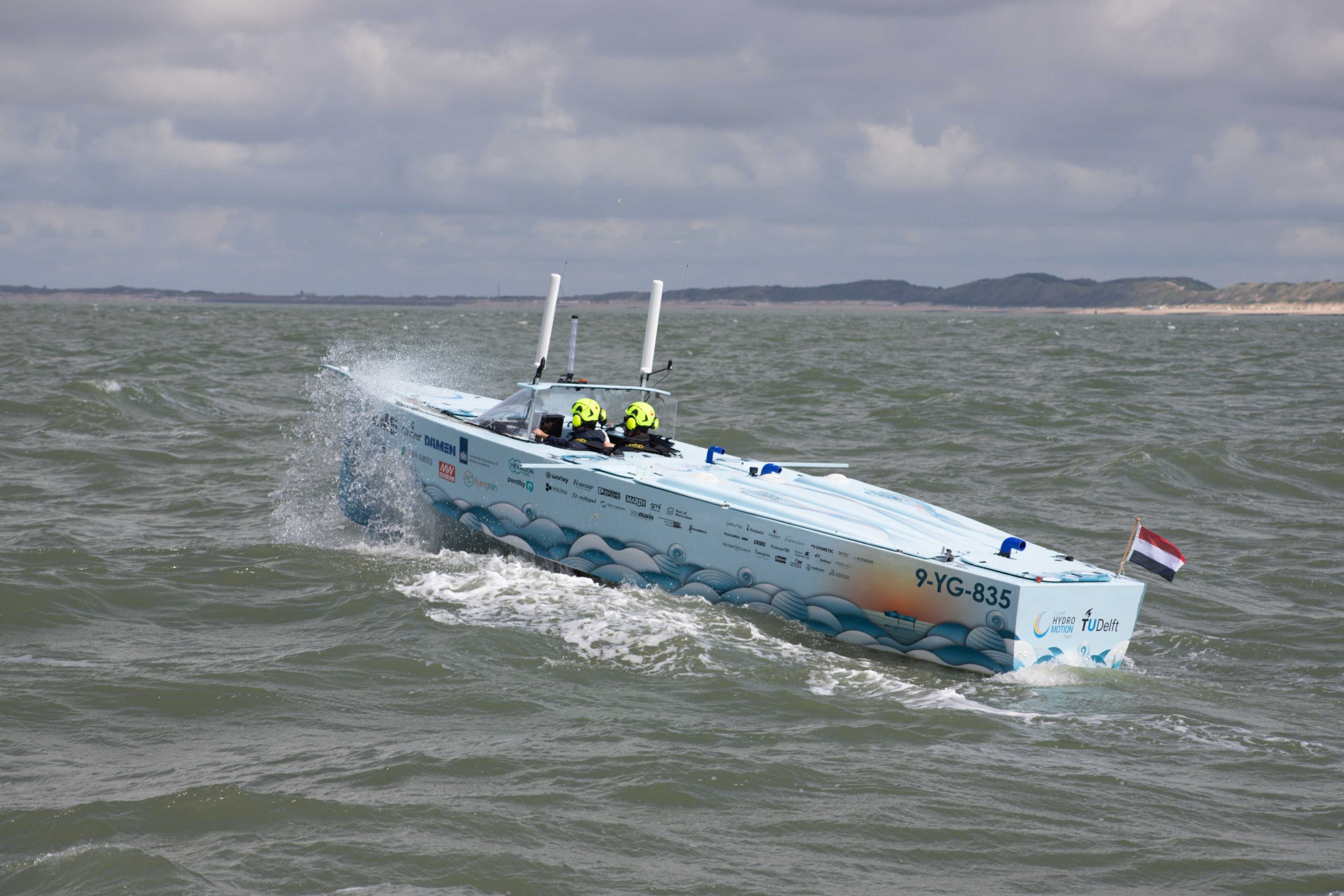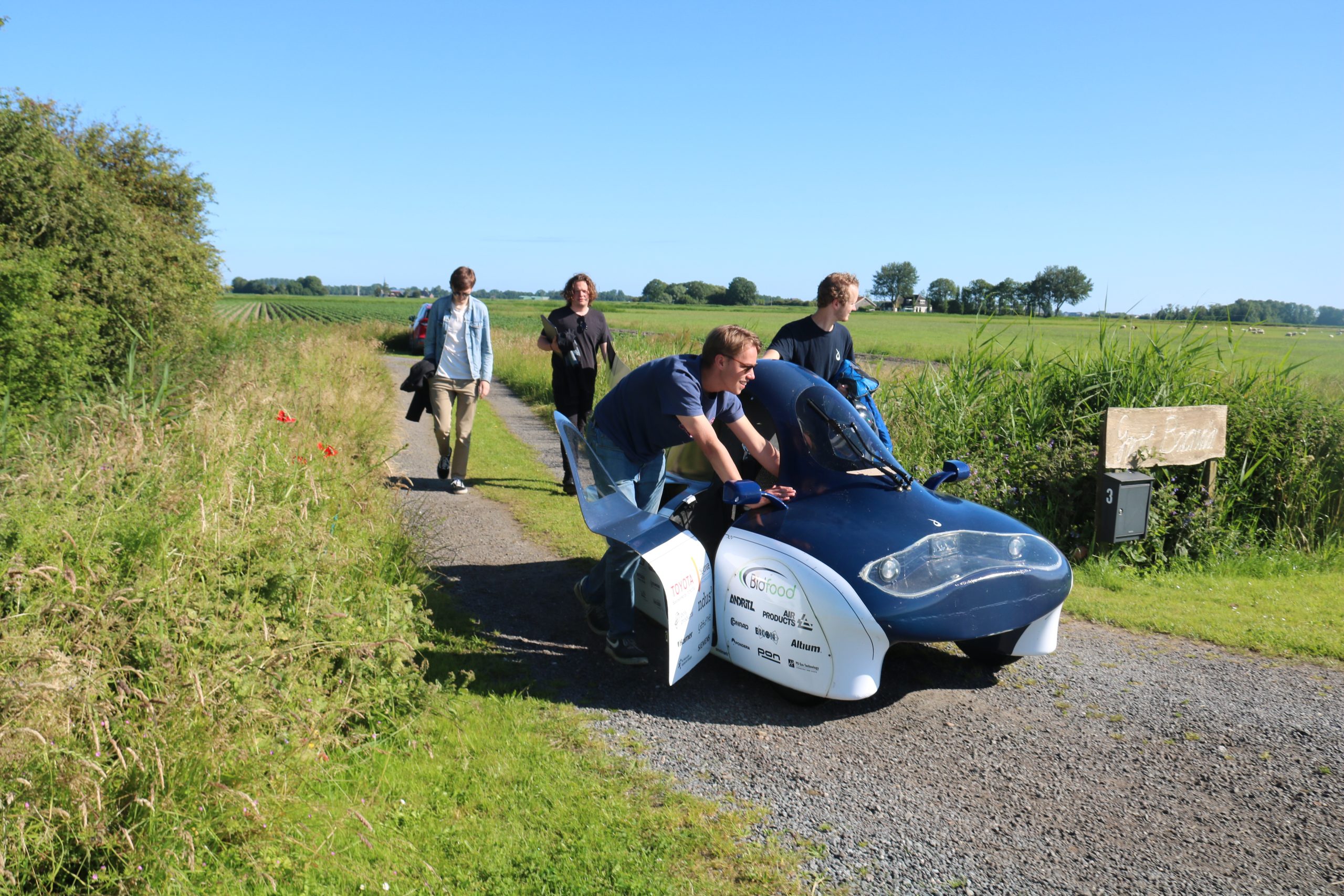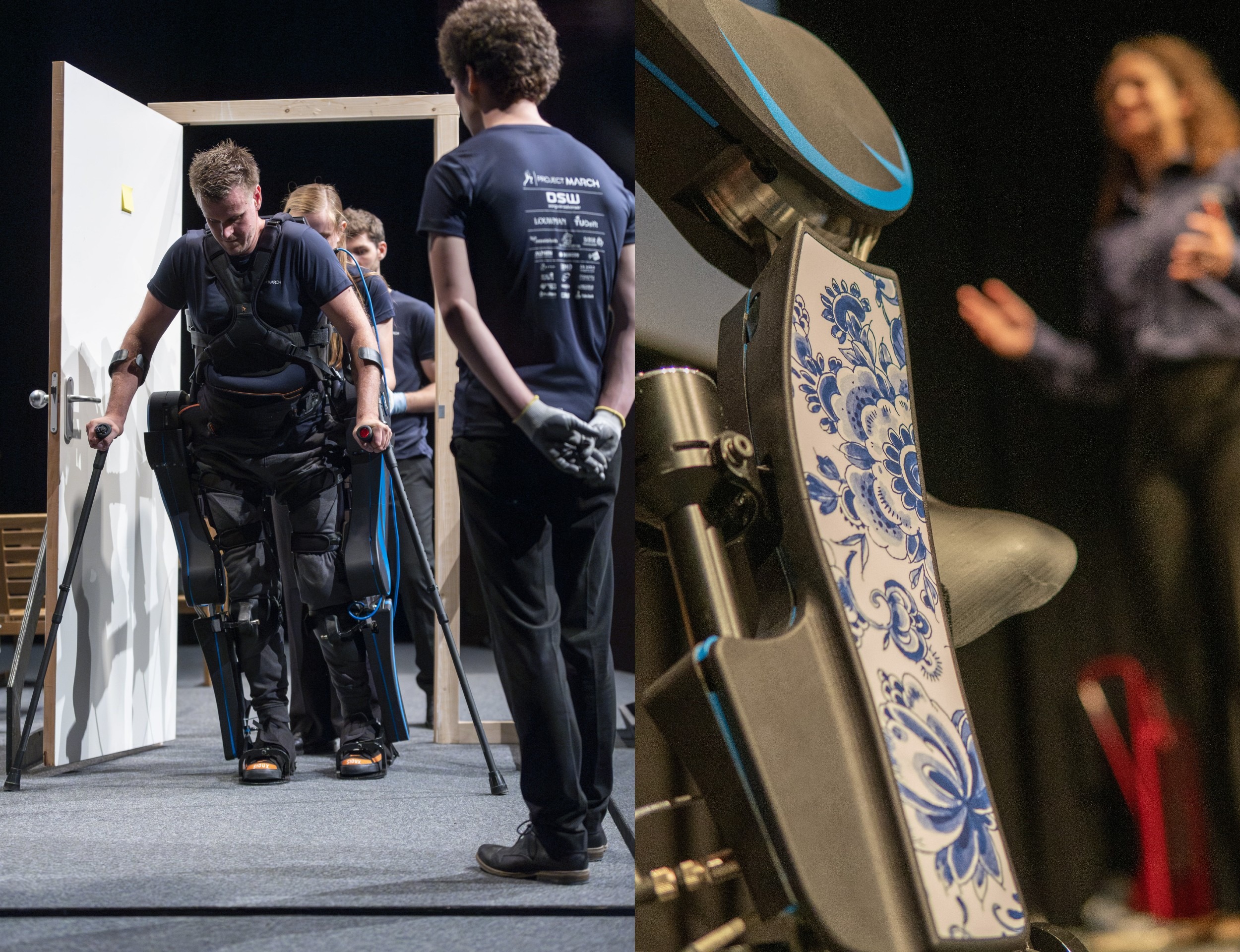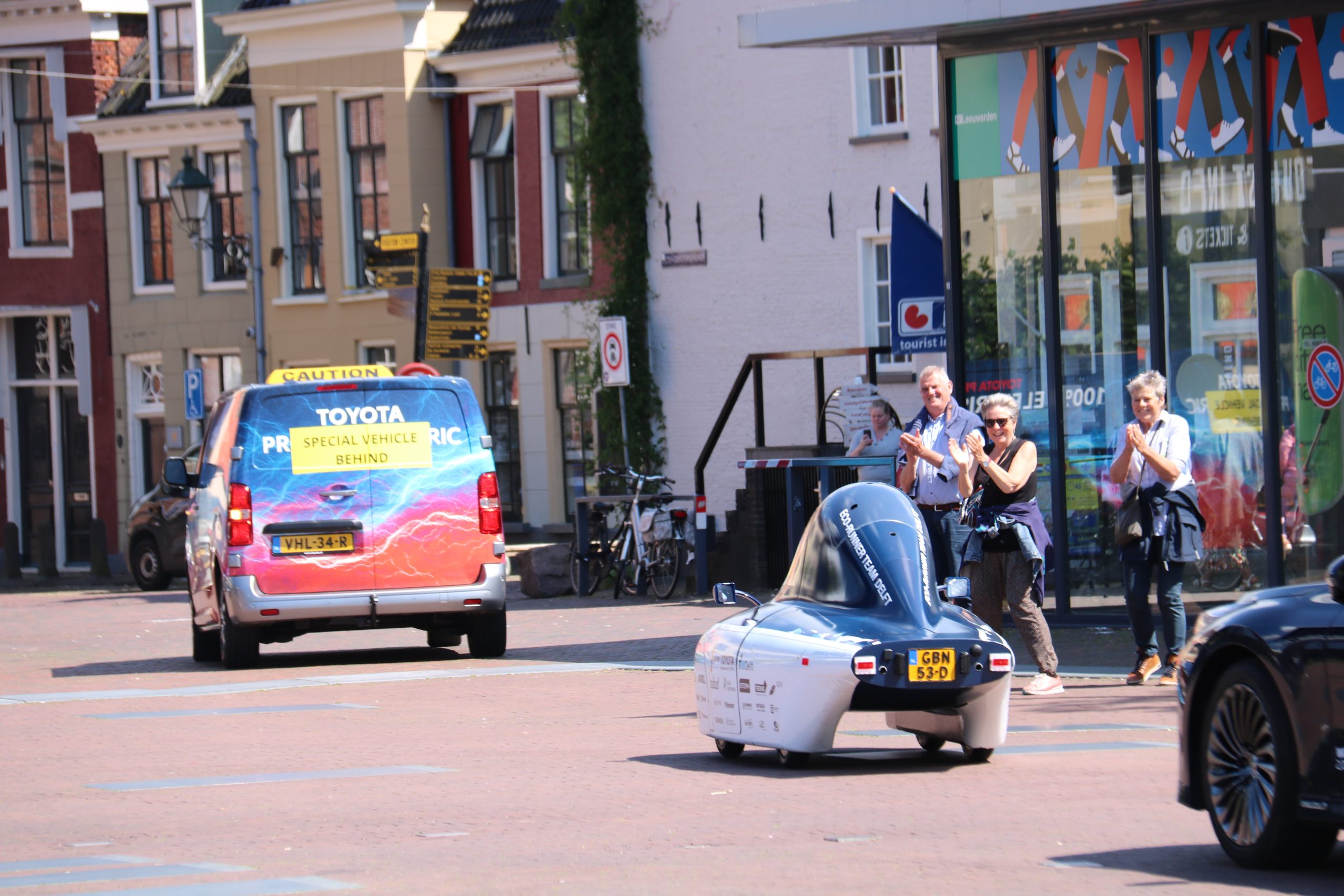During the summer, many student teams attempt records with their self-developed technology. This year, they were Project March, Eco-Runner, Hyperloop and Hydromotion. Delta lists their achievements.
The Eco-Runner XIV is the first student-built hydrogen that was declared street-legal by the Dutch RDW authority. (Photo: Eco-Runner Team Delft).
Hydro Motion Team crosses to England on 12 kilograms of hydrogen

The Ramsgate jetty was crowded despite the late hour. The 23 students of the Hydro Motion Team and their escorts were delirious with joy when their hydrogen powered boat pulled into the harbour around 23:00 on 11 July 2024, accompanied by a larger working vessel from Sima Charters. They had achieved their goal: emission-free crossing from the Netherlands to England in a boat powered by green hydrogen. It was a self-imposed challenge after the previous team had convincingly won the Monaco Energy Boat Challenge. The 169 kilometre Channel crossing took 12 hours and 12 kilograms of hydrogen. The average speed was around 18 kilometres per hour.
The crossing was a complex operation that required extra preparation in terms of safety and logistics. For instance, because of weather dependency, no precise date could be set, but instead a week in which the weather was likely to be favourable. Sure enough, the first attempt on 9 July was cancelled due to technical failures and threats of thunderstorms. Two days later, the boat did leave Breskens harbour. Soon, one of the cooling pumps broke down, so the team decided to call at Zeebrugge port for repairs. After replacing the pump, they continued the journey and reached the other shore at night.
The crossing was scheduled to take about half as long as the hydrofoil boat was expected to reach a speed of about 40 kilometres per hour. But a persistent malfunction in the control system of the hydrofoils meant that the team decided to just let the eight metre long motorboat sail through the water on its hull. “We also have to make sure the next team has something to do,” jokes Jeroen von Berg, the Press Officer.
Having achieved this, the Hydro Motion Team hopes to show the maritime world the way to emission-free green hydrogen as a fuel. While green hydrogen (from renewable electricity) is currently still expensive and hard to come by, maritime fuel cell technology is improving every year.
Eco-Runner Team Delft drives 1,273 kilometres on one tank of hydrogen

Just outside the Frisian town of Sloten, the Eco-Runner XIV came to a final halt on 24 June. The student team had used up the last bit of hydrogen in the tank to recharge the battery for the final kilometres on a quiet road along the water. There, the Eco-Runner stopped. It got going and then stopped again. In the end, the team recorded an impressive 1,273 kilometres on one tank (1.45 kilograms) of hydrogen. They had covered the Frisian Elfstedentocht (an ice-skating route along 11 towns in the province of Friesland) route six times in the past week. “This was the moment we had all been working towards for 10 months,” PR manager Isabel Zijlmans told Delta afterwards. “We were incredibly proud, and we celebrated by writing all our names on the car’s base plate.”
The Eco-Runner teams have used hydrogen to fuel their hyper-efficient vehicles since 2021. Last year, the Eco-Runner XIII achieved a Guinness World Record by covering 2,488.5 kilometres on a circuit in three days on just 950 grams of hydrogen. This year, the new Eco-Runner Team XIV decided to take on a new challenge: a hydrogen car with RDW (the Netherlands Vehicle Authority) approval to drive on public roads.
This year’s record attempt was thus not held on a race track but on the Elfstedentocht road network in Friesland where, for safety reasons, the little Eco-Runner drove between a van and a Toyota Mirai. Traffic lights, roundabouts, acceleration and braking all meant that they could not match the world record. As did all the road driving requirements which doubled the weight of the Eco XIV compared to its predecessor. Thus, this year’s record attempt may have been less economical, but it was more realistic than previous attempts.
- Read the team’s report on the Eco-Runner website
TU Delft Hyperloop wins awards but misses out on first prize

A brake failure at the wrong time meant that the Delft Hyperloop team missed out on first place in the European Hyperloop Week finals on 20 July 2024. Hyperloop is the futuristic public transport system where passengers move at high speed through vacuum tubes in enclosed cabins. At European Hyperloop Week, 26 university teams were competing for recognition of their technology.
Before the failure at the finale, the Delft team had been rather successful. But the brake glitch left the TU Delft team finishing fourth behind HyperloopUPV (TU Valencia), mu-zero Hyperloop (Baden-Würtenberg) and the ETH home team Swissloop.
“In the morning, we successfully demonstrated contactless hovering to the jury,” press officer Noor Rinkes explains afterwards. “But in the afternoon, during the system demonstration, when the power was switched on, the brakes also activated immediately. We think there was a magnetic fault. We could have fixed it, but there was no time.”
In the run-up to the final, the TU Delft student team had already demonstrated a world first: a contactless track switch, for which they built a demo track on campus. The track switch earned them an award in the infrastructure category, in addition to a prize for heat management for dissipating heat in a vacuum. A theoretical solution for an airlock, which allows passengers to board while the hyperloop is in a vacuum, won the so-called full-scale award.
For Rinkes, the glass is half-full after the European Hyperloop Week in Zurich: “We are especially proud that we were the first to demonstrate a track switch in the Netherlands. That is quite an achievement for us and it makes us very happy.”
- More info on the Delft Hyperloop Team
Project March in training for Cybathlon 2024

It is as quiet as a mouse in the packed theatre hall as nine students and a seated man rise from the depths onto the stage. It’s Monday afternoon in the Louwman Museum in The Hague on 22 July 2024. ‘Three, two, one’, it sounds. And with a buzzing sound, the man, leaning heavily on his crutches, rises from his seat. He takes a couple of sidesteps, and then a series of small steps to a door which he opens. When the man, accompanied by students, sits back down on the other side, there is not only loud applause but also many sighs of relief. The exoskeleton really works: it enabled paraplegic patient and pilot Daan van der Heyden to stand up and walk. Albeit with small cautious steps.
A lot of training is still needed, Team Manager Kim Adams said earlier. Today’s presentation, on Monday 22 July, is not Project March’s final goal. That is competing in the 2024 Cybathlon in Zurich between 25 and 27 October. “This is the Olympics for people with physical disabilities and the university teams that support them,” Adams said. There, the team will have to successfully complete 10 walking and agility tests within 10 minutes. Now that the exoskeleton, the self-walking robotic pair of legs, is ready, training and fine-tuning can begin. “We have 69 days left,” she says.
Project March IX has built on the successes of previous teams since 2015. Each team, made up of 28 students this year, designs and produces another exoskeleton, improved from the previous one. As key improvements this year, Chief Engineer Max Lauf cites the enhanced joints that saves 25% in weight (some 10 kilograms), the flexible connections to the feet for sloping surfaces, and the intuitive controls in the right crutch with Bluetooth connectivity.
- Was your team also successful and did it go unnoticed? Let us know and send an e-mail using the link below.
Do you have a question or comment about this article?
j.w.wassink@tudelft.nl


Comments are closed.